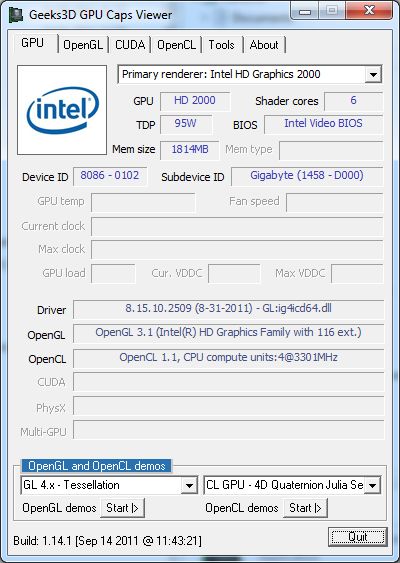
GMA 950 on Intel DG945GCPE motherboard (only visible) The Intel Graphics Media Accelerator, or GMA, is a series of introduced in 2004 by, replacing the earlier series and being succeeded by the series. This series targets the market of low-cost graphics solutions. The products in this series are integrated onto the motherboard, have limited graphics processing power, and use the computer's for storage instead of a dedicated. They are commonly found on, low-priced and, as well as business computers which do not need high levels of graphics capability. In early 2007, about 90% of all PC sold had an integrated. This section needs additional citations for. Unsourced material may be challenged and removed.
2 days ago - The Intel Graphics Media Accelerator 4500MHD (sometimes also called GMA X4500 HD or other. The 400MHz clocked version of the 4500MHD found in the GL40 and GS40 chipsets. Cinebench R11.5 OpenGL 64Bit +. Opengl Version For Intel Gma 4500 Hd Posted on 1/19/2018 Intel® HD Graphics - Built for Mainstream Desktop and Mobile PC Users Intel® HD Graphics provides superb visual performance for sharper images, richer color, and lifelike video and audio. Clinical orthopaedic examination fifth edition by ronald mcrae free download.
Find sources: – ( August 2011) () The GMA line of GPUs replaces the earlier, and the line, the latter of which was a discrete unit in the form of and cards with technology that evolved from companies. Later, Intel integrated the i740 core into the chipset. The original architecture of GMA systems supported only a few functions in hardware, and relied on the host CPU to handle at least some of the graphics pipeline, further decreasing performance. However, with the introduction of Intel's 4th generation of GMA architecture () in 2006, many of the functions are now built into the hardware, providing an increase in performance. The 4th generation of GMA combines fixed function capabilities with a threaded array of programmable executions units, providing advantages to both graphics and video performance.
Many of the advantages of the new GMA architecture come from the ability to flexibly switch as needed between executing graphics-related tasks or video-related tasks. While GMA performance has been widely criticized in the past as being too slow for, sometimes being nicknamed Intel GMD (Graphics Media Decelerator) and being essentially referred to as the world's first 'graphics decelerator' since the, the latest GMA generation should ease many of those concerns for the casual gamer. Despite similarities, Intel's main series of GMA Integrated Graphics Processors (IGPs) is not based on the technology Intel licensed from Imagination Technologies.

Intel used the low-power designs in chipsets supporting their platform, and since the sale of XScale in 2006 has licensed the and used it in the IGP for use with their platform. With the introduction of the, the Graphics Media Accelerator series ceased, and the CPU-based series was created. Graphics cores [ ] Intel GPU based [ ] Generation three based [ ] GMA 900 [ ] The GMA 900 was the first graphics core produced under Intel's Graphics Media Accelerator product name, and was incorporated in the. The 3D architecture of the GMA 900 was a significant upgrade from the previous Extreme 3D graphics processors. It is a 4 pixel per clock cycle design supporting DirectX 9 pixel 2.0. It operates at a clock rate ranging from 160 to 333 MHz, depending on the particular chipset. At 333 MHz, it has a peak pixel fill-rate of 1332 megapixels per second.